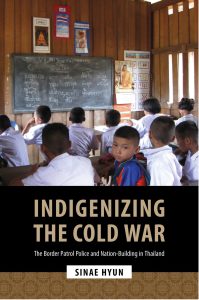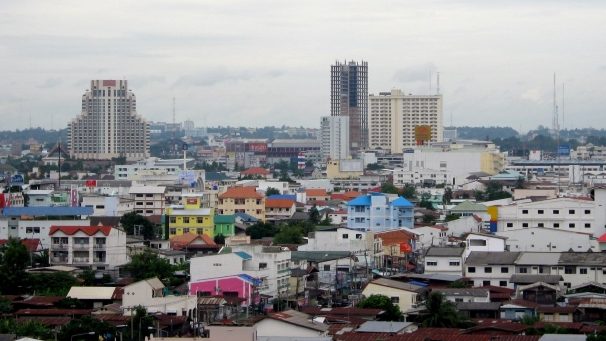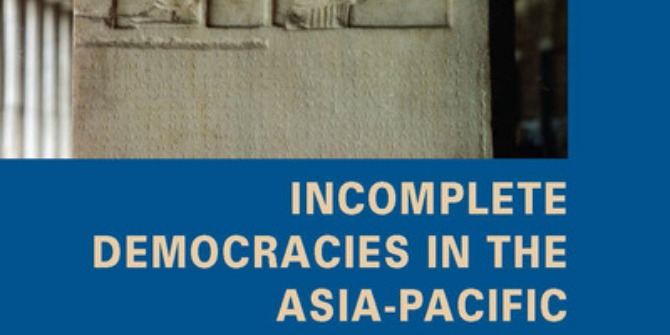Indigenizing the Cold War: Nation-Building by the Border Patrol Police in Thailand by Sinae Hyun explores the effects of the Cold War on Thailand’s nation-building process, specifically on the transformation of the Border Patrol Police (BPP) from a force supported by the CIA to a civic action agency. Applying the analytical lens of indigenisation, the book vividly describes the interplay between anti-communist mobilisation and nation-building during this period, writes Xu Peng. This post was originally published on the LSE Southeast Asia Blog.
Indigenizing the Cold War: Nation-Building by the Border Patrol Police in Thailand. Sinae Hyun. University of Hawaii Press. 2023.
 The main argument of this book is that the Cold War in Thailand was not just an ideological struggle between communism and anti-communism but a complex interplay between local elites and the general populace. The book highlights two key historical continuities: the Thai ruling elite’s collaboration with the US to establish Thailand as a bastion of anti-communism and leveraging US Cold War policies to advance Thai military and royal agendas. This work offers valuable insights into Southeast Asian studies, Cold War history, and political science by exploring the complexities of nation-building and the role of global superpowers in local affairs.
The main argument of this book is that the Cold War in Thailand was not just an ideological struggle between communism and anti-communism but a complex interplay between local elites and the general populace. The book highlights two key historical continuities: the Thai ruling elite’s collaboration with the US to establish Thailand as a bastion of anti-communism and leveraging US Cold War policies to advance Thai military and royal agendas. This work offers valuable insights into Southeast Asian studies, Cold War history, and political science by exploring the complexities of nation-building and the role of global superpowers in local affairs.
The author astutely observes that the revival of monarchical influence [in Thailand] was not an isolated phenomenon but a strategic move that dovetailed with anti-communist politics during this period [1947-1962]
The first chapter, “From CIA Brainchild to Civic Action Agent, 1947-1962,” serves as a foundational piece, setting the stage for the intricate transformations the Border Patrol Police (BPP) would undergo. The author astutely observes that the revival of monarchical influence was not an isolated phenomenon but a strategic move that dovetailed with anti-communist politics during this period. This alignment of interests between the Thai military and the monarchy was not merely coincidental but rather a calculated strategy that drew substantial support from the United States. This chapter illuminates how international geopolitics and local political imperatives can intersect, thereby mutually reinforcing each other. Moving on to the second chapter, “Building a Human Border, 1962-1980,” the author delves into the complexities of nation-building and bordercraft. The BPP’s initiatives in remote mountainous regions, which included sanitation, health, rural economic development, and narcotics suppression, were not merely civic actions. Rather, they were strategic moves designed to maintain a hierarchical relationship between the hill tribes and mainstream Thai society. Far from aiming to integrate these ethnic minorities into the Thai nation, these activities deliberately kept the highland minorities at arm’s length, serving to legitimise the nation-building process led by the existing ruling elite.
The author argues that [the 6 October1976 Massacre] epitomises how the Thai ruling elite, whether military or monarchy, successfully indigenised American anti-communist strategies to serve their own ends
The third chapter, “The Saga of the Black Panther, 1950-1976,” offers a nuanced look into the Police Aerial Reinforcement Unit (PARU) and its role within the broader framework of the BPP and the Cold War. Initially formed as a CIA paramilitary force, PARU faced existential challenges, particularly when Sarit Thanarat seized power in 1957. In order to survive, the unit was deployed to Laos for clandestine operations, securing US military aid for Thailand in the process. However, when the Laos operation faltered, PARU returned to Thailand as a demoralised unit. At this juncture, the Thai monarchy adopted PARU as an agent of indigenisation and royalist nationalism. The chapter reflects on the complexities of survival, allegiance, and identity. It highlights how local actors like PARU were not merely pawns but active agents in shaping their destinies within shifting geopolitical landscapes. In the fourth chapter, “Crusade from the Borders to Bangkok, 1969-1976,” the focus shifts to the 6 October Massacre, a watershed moment in Thai history. The author argues that this event epitomises how the Thai ruling elite, whether military or monarchy, successfully indigenised American anti-communist strategies to serve their own ends. The formation of the Village Scouts by the BPP and their role in the massacre is a stark reminder of how state-sponsored initiatives can have far-reaching and often devastating consequences. The concluding chapter, “Mission Incomplete,” serves as a reflective epilogue, pondering the long-term impacts of the indigenised Cold War on Thai society. The chapter scrutinises the transformation of King Bhumibol from a traditional royal patron to a modern nation-builder. It also examines the legacies of Thai-style democracy and royalist nationalism, which continue to exert a profound influence over Thai society. The chapter raises pertinent questions about the future role of the BPP, especially given its ambiguous identity constructed during the Cold War era.
The ruling elite engaged in a calculated ‘othering’ process, setting up psychological borders between ‘friend’ and ‘foe,’ ‘us’ and ‘them.’[…] to marginalise political dissidents and others posing threats to the regime, often labelling them as communists irrespective of their actual affiliations
One of the most salient strengths of Indigenizing the Cold War lies in its nuanced understanding of the postcolonial nation-building process. The author compellingly argues that under the aegis of the global Cold War system, nation-building was not merely a territorial project but also a psychological one. The ruling elite engaged in a calculated ‘othering’ process, setting up psychological borders between ‘friend’ and ‘foe,’ ‘us’ and ‘them.’ This strategy was particularly effective as it employed ambiguous criteria to determine who were communists and who were not, thereby consolidating the state’s authority. The ruling class weaponised this ‘othering’ tactic to marginalise political dissidents and others posing threats to the regime, often labelling them as communists irrespective of their actual affiliations. This strategy essentially conditioned the nation to fear and respect the authority of the state, as it was the state that had the ultimate say in meting out punishment or rewards. Additionally, the book offers a unique perspective on communism’s impact on Southeast Asia. The narrative tends to depict communism more as an abstract, distant threat rather than a tangible force with ebbs and flows. This portrayal could be a deliberate choice by the author to underscore how the concept of communism was often manipulated or reconstructed to fit specific narratives.
Another significant strength of the book is its nuanced analysis of the BPP’s role, which the author describes as a ‘symbolic missionary of nationalism’(page 5). The term ‘missionary’ is employed to signify the BPP’s active role in disseminating and reinforcing nationalist ideologies, a role in which it was patronized and emboldened by the Thai ruling elite, particularly the monarchy. The BPP is not merely a security force but a formalised institution that epitomises the collaboration between the United States and the Thai monarchy up to 1974. While the book provides an exhaustive account of the BPP’s role in Thai nation-building, it could benefit from situating the BPP within a broader context. Specifically, the BPP acts as a broker between ethnic minorities and the ruling regime, and it is worth noting that Thailand often employs a more direct form of intervention, particularly in the use of forest land rights in border areas, to complete the state’s control of the border through processes of territorialisation. These top-down processes, like the civic initiatives led by the BPP, are instrumental in nation-building. Therefore, the correlation between the BPP and other state-led initiatives in nation-building should also be considered for a more comprehensive understanding.
While the book does touch upon the bureaucratic hindrances to the assimilation of mountain peoples, as mentioned in Chapter 2, ‘The Human Border,’ it still lacks a comprehensive account of resistance or agency from these communities
The core issue that emerges from the book is its portrayal of nation-building as a largely one-way process, focusing predominantly on the actions and strategies of the state or its agents (or broker), such as the BPP. While the book does touch upon the bureaucratic hindrances to the assimilation of mountain peoples, as mentioned in Chapter 2, ‘The Human Border,’ it still lacks a comprehensive account of resistance or agency from these communities. This absence is significant because it is difficult to gauge the effectiveness of nation-building without considering this component of resistance. The book’s one-sided portrayal simplifies what should be understood as a complex, two-way interaction between the state and the people in ungoverned areas. This leads to a further point of curiosity: Which concept of ‘nation-building’ is the book discussing? Is it the ‘united, progressive nation-state’ that the author describes as challenging to build, or is it a more inclusive concept of the nation? While the author’s final conclusion does reflect on the limitations of the concept of nation-building, it leaves room for further exploration and discussion.
The book excels in its theoretical contributions, particularly the concept of ‘indigenisation.’ […] Compared to the more commonly used term ‘localisation,’ ‘indigenisation’ serves as a more potent analytical tool to highlight the reciprocity involved in creating and sustaining conditions for collaboration and adaptation between the U.S
Lastly, the book excels in its theoretical contributions, particularly the concept of ‘indigenisation.’ The author employs the metaphor of ‘missionisation’ in missiology to elucidate the work and practices of missionaries who aimed not merely to convert indigenous people but also to bring them under their mission’s sphere of influence and control. Compared to the more commonly used term ‘localisation,’ ‘indigenisation’ serves as a more potent analytical tool to highlight the reciprocity involved in creating and sustaining conditions for collaboration and adaptation between the U.S. and its Southeast Asian allies during the Cold War. Significantly, the book integrates this theory of ‘indigenisation’ exceptionally well, particularly in chapters one through five. It demonstrates a progressive increase in the degree of ‘indigenisation,’ culminating in the 6 October Massacre, representing the apex of full ‘indigenisation.’ This observation adds another layer of depth to our understanding of how the theory is not just static but evolves and intensifies over time, thereby enriching our understanding of Cold War dynamics in Southeast Asia.
This book review is published by the LSE Southeast Asia blog and LSE Review of Books blog as part of a collaborative series focusing on timely and important social science books from and about Southeast Asia. This review gives the views of the author, and not the position of the LSE Review of Books blog, the LSE Southeast Asia Blog, or the London School of Economics and Political Science.
Main Image Credit: Wasu Watcharadachaphong on Shutterstock.







